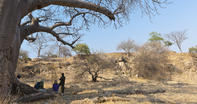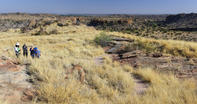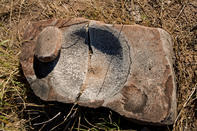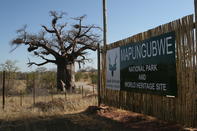Quick Facts
Mapungubwe is located in the north western corner of South Africa, at the confluence of the Limpopo and Shashe rivers. It is on the border with Botswana and Zimbabwe, opposite the Tuli Block. About 1000 years ago, this was the centre of a large and powerful civilisation that traded extensively with merchants based on the east coast of Africa.

There are more than 200 associated archaeological sites in the vicinity and three ‘capitals’ that were inhabited at different times: Zhizo, K2 and Mapungubwe Hill. The capital at Mapungubwe Hill was the largest and wealthiest. The king lived in splendid isolation on top, while his people lived on the terraces around the foot of the hill.
After the collapse of the civilisation, 700 years ago, the tribes that remained in the area refused to go near the hill, believing it to be a sacred place where the ancestors lived.
The hill was first discovered by white people in 1932, when a blind old man named Mowena was persuaded to point out the legendary hill to a teacher named Van Graan. Van Graan and his friends found a number of graves on top of the hill that were filled with marvellous funerary objects, the most famous being a complete Rhino figurine made of gold foil.
Mapungubwe Mystery and Myths

Even though Mapungubwe was one of the earliest civilisations in Sub-Saharan Africa, it has been shrouded in mystery and myth for much of the last 700 years. And there are a number of reasons for this gap in knowledge. Firstly, as is the case with many other ancient civilisations in South America and the Middle East, there is little continuity between the ancient Mapungubwe people and their modern counterparts, beyond a few poorly understood taboos and legends.
Furthermore, the Mapungubwians did not leave behind any written records, and verbal history generally does not reach back more than a few hundred years at most. Furthermore, the world of the Bushmen and the organisation of Bantu iron-age settlements were glossed over or actively ignored by text books, and this has resulted in a skewed perception that nothing much happened in Southern Africa until the Europeans arrived in the 1500s.
Pre 1994 Education

Post 1994

In 1997, the history syllabus was updated to include a more complete picture of African prehistory, and Mapungubwe was restored to its rightful place in our national consciousness. The major Mapungubwe sites are now safely ensconced within the protective borders of a newly-formed National Park.
It is also telling to note that the highest honour awarded by the government to South Africans for ‘excellence and exceptional achievement’ is called the Order of Mapungubwe. This is the story of Mapungubwe. It is a strange and enigmatic tale, filled with intriguing secrets that are illuminated only by flashes of gold, fragments of pottery and a few human remains. It is also a fascinating and rich narrative of ancient civilisations and remarkable discoveries.
By David Fleminger